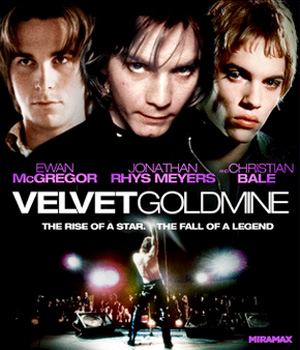 Velvet Goldmine
Velvet Goldmine
Directed by Todd Haynes
Written by James Lyons and Todd Haynes,
Released October 23, 1998 (UK)
Drama (historical)
124 min.
Review by Stephen O. Murray
July 18, 2001.
To understand the plot of Todd Haynes’ 1998 Velvet Goldmine, I had to watch everything twice or more often, with the subtitles on, after first watching the whole film through. In a theater, the sensory overload may have been greater with the sound louder, but being able to go back to earlier scenes on the DVD is a major boon — at least for those who want to make sense of what they’ve seen. I presume that others know the appropriate drugs to take to augment such an experience…
The “mystery” (why Brian [Jonathan Rhys-Meyers] faked his own on-stage murder) is not all that interesting to solve, while soulfully sad-eyed as reporter and childhood fan Arthur Stuart, as played by Christian Bale, is. The stone that dropped from outer space along with Oscar Wilde and his mid-20th-century reincarnation (I’ve already forgotten whether that was Jack Fairy or Brian Slade) is a stupid framing story.
The Citizen Kane research angle pays off primarily in Stuart tracking down and interviewing Mandy Slade [compellingly played by Toni Collette]. Among other things, she recalls finding her husband Brian naked and asleep with Curt Wild [Ewan McGregor] and being told that seeing two people naked in bed together is not proof of a sexual relationship—four second pause—but, on the other hand, is strong reason to suspect one. Even as uninformed about the private lives of 1960s and ’70s rock stars as I am, I recognize this as deriving from Marianne Faithful’s memoir mentioning finding her then-husband (Mick Jagger) and David Bowie in bed together.
Brian Slade looks and sounds like David Bowie of the early 1970s. McGregor looks like Kurt Cobain, behaves (e.g., strips) like Iggy Pop, and sounds (I’m told) like the Stooges. And I gather that Jack Fairy and the film’s title are inspired by Lou Reed. (The part is played by Michael Feast.) Those with some familiarity with the “glam rock” scene of the early 1970s can identify other elements from various androgynous divas’ lives and careers.
I’d guess that the scene I like most, a highly stylized press conference, was inspired in some part by Bob Fosse’s All That Jazz. Brian is being harried until Curt enters the ring and reassures Brian, as the camera circles them. There is also an earlier, less stylized, but still delightful press conference in the movie in which Brian touts his and his wife’s bisexuality.
Although McGregor is top-billed and his character important, the movie is primarily about the rise and implosion of Brian Slade. Rhys-Meyers is sufficiently pouty and alternates between Christ-like acceptance of pain and brattiness, but the character as written is hollow. Perhaps Brian is supposed to be hollow, not just that his fame and whatever fortune he may have amassed—one would guess not very much with Eddie Izzard as his agent, Jerry Devine!—are being revealed as hollow. Stars have to be unfulfilled and unhappy in movies about their lives so that we don’t envy them, right?
For narrative or character development the script is very defective, and these defects of logic and continuity are made even more unintelligible by the editing of scenes from different times with little or no indication of which is flashback. I was particularly thrown by Arthur’s meeting with Curt after one of Curt’s performances.
I am probably expecting too much coherence from a two-hour music video with the music from an age of particular excess. Reporter Arthur appalled both his parents and his macho age mates by doting on that “poofty” stuff when he was an adolescent. Although some of his mortifying memories of his schoolgirlish crush on Brian Slade appear on-screen, the viewer does not find out what he thinks about that distant past (1970 as viewed from 1984 in this 1998 movie). Indeed, the only character whose view of that time is developed is Mandy.
Director Haynes, cinematographer Maryse Alberti, and editor James Lyons concocted a visually striking hodgepodge of dreams, memories, ’70s music, ’70s clothes, and gender-bending bisexuality. The movie will primarily appeal to those liking that kind of music and the campy space-oddity alienation often celebrated in it.
A note on the music: I already knew from Moulin Rouge that McGregor didn’t have much of a voice, but it is adequate for what he had to perform in VG. Rhys-Meyers rose to more substantial vocal demands, even if his character is more of a cypher than McGregor’s. Most of the songs are performed by the two of them, though Lou Reed’s voice is on the soundtrack for Jack Fairy’s songs. And “Cosmic Dancer” (also revived for Billy Elliott) is T. Rex’s original, not a cover.
published by epinions, 18 July 2001
©2001, 2016, Stephen O. Murray


